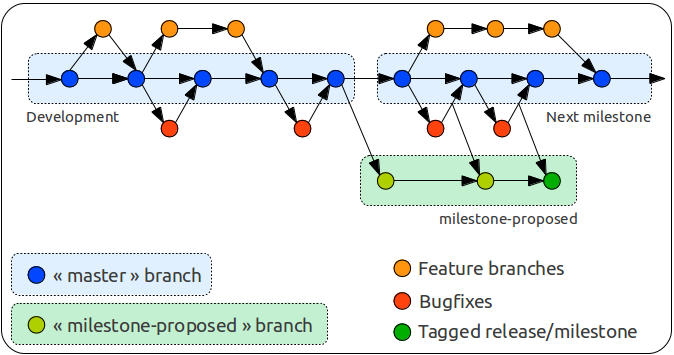Difference between revisions of "Branch Model"
m |
(Refreshed) |
||
| Line 1: | Line 1: | ||
| + | == Model == | ||
| + | |||
Starting with the Diablo cycle, OpenStack core projects use a branching model close to the [http://nvie.com/posts/a-successful-git-branching-model/ NVIE model] that ensures an almost-always-open ''master'' while still allowing to freeze features and select bugfixes in a release branch (''milestone-proposed''): | Starting with the Diablo cycle, OpenStack core projects use a branching model close to the [http://nvie.com/posts/a-successful-git-branching-model/ NVIE model] that ensures an almost-always-open ''master'' while still allowing to freeze features and select bugfixes in a release branch (''milestone-proposed''): | ||
| Line 5: | Line 7: | ||
At some point before the release of a milestone (called the "branch point"), the ''milestone-proposed'' branch gets created out of the master branch. The master branch continues towards the development of the next milestone. The ''milestone-proposed'' branches gets testing and backported bugfixes (that must land in ''master'' first), until the release is tagged. | At some point before the release of a milestone (called the "branch point"), the ''milestone-proposed'' branch gets created out of the master branch. The master branch continues towards the development of the next milestone. The ''milestone-proposed'' branches gets testing and backported bugfixes (that must land in ''master'' first), until the release is tagged. | ||
| − | = Version numbers = | + | == Version numbers == |
| + | |||
| + | Integrated projects use a YEAR.SEQUENCE numbering scheme for the common releases. Libraries use a more flexible MAJOR.MINOR.PATCH classic versioning. | ||
| − | + | Starting with Grizzly's grizzly-3 development milestone, we no longer produce per-commit versioned tarballs. Instead we produce a number of tarballs: | |
| − | + | ==== Branch tarballs ==== | |
| − | + | Every commit to the master or milestone-proposed branches results in the PROJECT-BRANCH.tar.gz tarball on http://tarballs.openstack.org/PROJECT to be renewed. This is done by the PROJECT-branch-tarball jobs on Jenkins, triggered by the friendly Zuul. | |
| − | |||
| − | |||
| − | |||
| − | + | ==== Tagged tarballs ==== | |
| − | + | Every time a tag is pushed to a repository, a corresponding PROJECT-TAG.tar.gz tarball is generated and uploaded to http://tarballs.openstack.org/PROJECT. This is done by the PROJECT-tarball jobs on Jenkins, triggered by the friendly Zuul. Additionally, tagged tarballs for OpenStack libraries are automatically uploaded to PyPI. | |
| − | |||
| − | |||
| − | + | ==== On-demand tarballs ==== | |
| − | |||
| − | |||
| − | |||
| − | |||
| − | |||
| − | + | If a user runs <code>python setup.py sdist</code> from a checkout of a PROJECT repository, it will generate a local PROJECT-VERSION.aXX.YYYYYY tarball. | |
Revision as of 16:55, 28 March 2013
Model
Starting with the Diablo cycle, OpenStack core projects use a branching model close to the NVIE model that ensures an almost-always-open master while still allowing to freeze features and select bugfixes in a release branch (milestone-proposed):
At some point before the release of a milestone (called the "branch point"), the milestone-proposed branch gets created out of the master branch. The master branch continues towards the development of the next milestone. The milestone-proposed branches gets testing and backported bugfixes (that must land in master first), until the release is tagged.
Version numbers
Integrated projects use a YEAR.SEQUENCE numbering scheme for the common releases. Libraries use a more flexible MAJOR.MINOR.PATCH classic versioning.
Starting with Grizzly's grizzly-3 development milestone, we no longer produce per-commit versioned tarballs. Instead we produce a number of tarballs:
Branch tarballs
Every commit to the master or milestone-proposed branches results in the PROJECT-BRANCH.tar.gz tarball on http://tarballs.openstack.org/PROJECT to be renewed. This is done by the PROJECT-branch-tarball jobs on Jenkins, triggered by the friendly Zuul.
Tagged tarballs
Every time a tag is pushed to a repository, a corresponding PROJECT-TAG.tar.gz tarball is generated and uploaded to http://tarballs.openstack.org/PROJECT. This is done by the PROJECT-tarball jobs on Jenkins, triggered by the friendly Zuul. Additionally, tagged tarballs for OpenStack libraries are automatically uploaded to PyPI.
On-demand tarballs
If a user runs python setup.py sdist from a checkout of a PROJECT repository, it will generate a local PROJECT-VERSION.aXX.YYYYYY tarball.

